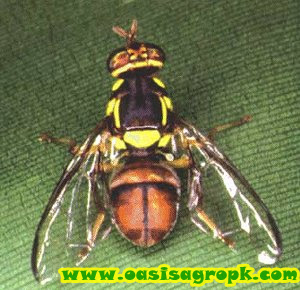| Species name | Bactrocera papayae |
| What does it look like? | The Asian papaya fruit fly is about the same length as a common housefly but more slender. It grows to 7 mm in length and has clear wings, generally black chest and a paler abdomen with a distinctive black T-shaped marking on the back. The Queensland fruit fly, by comparison, is much the same size but is an overall reddish-brown colour. An expert eye is needed to identify papaya fruit fly under a microscope. |
| Where does it occur? | Papaya fruit fly is endemic in Thailand, Malaysia, Borneo,
Indonesia and Singapore. It has been present in Papua New Guinea since 1992. In
March 1993, it was detected for the first time in Australian territory on the
islands of Saibai, Boigu and Dauan, adjacent to the Papua New Guinea coast; and
on Stephen and Darnley Islands close to the centre of Torres Strait.
Papaya fruit fly moves into the Torres Strait with the monsoonal winds each wet season and is eradicated annually as part of a proactive containment strategy administered by Biosecurity Queensland and the Australian Quarantine and Inspection Service. In October 1995, the detection of papaya fruit fly near Cairns initiated a major eradication campaign. This pest was successfully eradicated from the Cairns region in 1998, but Biosecurity Queensland remains vigilant and maintains a surveillance and trapping program throughout the state to ensure early detection should the pest reach the mainland of Queensland again. |
| Symptoms and damage | What makes this pest such a problem is that it infests twice the
number of fruit types as the Queensland fruit fly (209 compared with 116), many
of them at a greener stage.
As a result of the pest's heavy infestation habits, revised field control strategies would be needed should it become established in horticulture production regions. Earlier applications of spray regimes and more intensive or regular treatments will be required in some crops, because of the higher levels of damage papaya fruit fly can inflict and its tendency to attack some fruit at a greener stage. Many countries have trade restrictions on fruit that come from regions known to have papaya fruit fly. Should this exotic fruit fly species establish in Queensland, growers may face market access difficulties when exporting their produce. |
| Life cycle | Adult female flies lay their eggs just under the skin of fruit,
depositing fruit decaying bacteria at the same time. Within one to two days, the
eggs hatch into maggots (larvae) which feed on the decaying fruit, causing
premature fruit drop. Considerable damage can occur inside the flesh before
obvious signs of infestation can be seen on the fruit. The most obvious signs of
infestation are small discoloured patches on the skin, which develop from
punctures or stings made by the female as she lays her eggs.
It takes 7-12 days for the larvae to leave the fruit to develop into pupae in the soil. Adults emerge from the pupae in another 10-14 days, and become sexually mature after one to two weeks. They live for several months and are capable of reproducing throughout their life span. Like most tropical fruit fly species, papaya fruit fly multiplies rapidly and can disperse over large distances. It is capable of establishing in any of the mainland states of Australia. |
| Surveillance | Biosecurity Queensland monitors a network of traps for papaya
fruit fly in high-risk urban and remote centres in Queensland. The Australian
Quarantine and Inspection Service is responsible for papaya fruit fly
surveillance on each inhabited island in Torres Strait. Biosecurity Queensland
acts quickly with well planned eradication strategies whenever papaya fruit fly
is detected on Queensland territory. Early detection of this pest greatly
enhances the likelihood that the pest could be eradicated again if it
re-establishes in mainland Queensland. |







0 comments:
Post a Comment